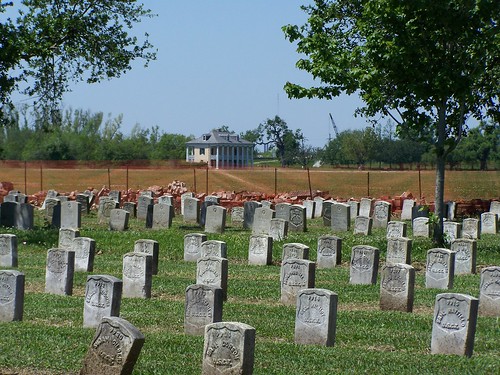Chalmette National Cemetery: A Historical Cemetery With a Rich Past
Shanna Riley February 19th, 2009

National Cemetery, Chalmette (New Orleans) La., originally uploaded by Casino Jones.
The War of 1812 essentially ended on January 8, 1815 with the Battle of New Orleans on Chalmette Battlefield in southern Louisiana. Four soldiers killed in that war were buried nearby on a large tract of land that would later become a national cemetery housing soldiers and veterans of every war from the Civil War to Vietnam - including the Spanish-American War and World Wars I and II.
It was during the Civil War, in May of 1864, that the 17.5 acre strip of land along the Mississippi River began being used as a burial ground for both the Confederate and Union dead in Louisiana. After the war, hastily buried soldiers around the state were moved to the more permanent national cemeteries. Over 12,000 of them found a final resting place in what is now Chalmette National Cemetery. In 1868, the 132 Confederate soldiers buried in the cemetery were moved by the Ladies Benevolent Association of New Orleans, with permission, to Cypress Grove Cemetery in New Orleans. In the following years, over 7,000 Union soldiers from around southern Louisiana and Mississippi were re-interred in the cemetery. While the cemetery is said to hold 12,000 Civil War dead, close to 7,000 of these are unknown soldiers.
Over the years, veterans and new casualties of war were buried in Chalmette National Cemetery; today, after a halt on new burials some time after the Vietnam war, the cemetery holds over 15,000 occupants. It is also the final resting place of many soldiers' wives and children.
A part of the Jean Lafitte National Historical Park and Preserve in Chalmette, Louisiana, it was listed on the National Register of Historic Places on October 5, 1966 along with Chalmette Battlefield, which sits adjacent to it. A veritable treasure trove of history lies buried beneath the green grass of this national cemetery.
The cemetery holds 113 members of the Native Guard; the first African-American soldiers in the Union Army. On September 27, 1862, the 1st Regiment of the Louisiana Native Guards was sworn into service. Controversial as the militia unit was, they contributed greatly to the war effort and later focused their energies on Reconstruction and promoting black rights.
The story of the Native Guards began with their enrollment as part of the Louisiana militia and ended with their participation in the civil rights movement during Reconstruction. As a militia unit, the Native Guards paraded with Confederate troops and sought to contribute to the Southern cause in other ways. After the fall of New Orleans, many of the officers and some of the men embraced the Old Flag by forming the first officially-sanctioned black regiment in the Union Army. During the war, the Native Guards fought at Port Hudson, Mansura, and Mobile. They also guarded prisoners, built fortifications, and contributed to the Union war effort in numerous other ways. Their service in the Union Army was as honorable as it was controversial. When the war ended, veterans of the Native Guards entered a third phase of their unusual career when they took up the struggle for black civil rights. - from The Louisiana Native Guards
Another piece of buried history lay beneath the damp earth at plot 4066 in Section 52 and was not discovered until 1994 when some old papers were found, forgotten, in the attic of an old home in upstate New York. The grave, from 1864, reads Lyons Wakeman, but the lost papers proved the grave's occupant was actually named Sarah. Nineteen year-old Sarah Rosetta Wakeman - known as Rosetta - found that posing as a man got her better paying jobs, and when the prospect of making $13/month as a soldier came up, Sarah jumped at the chance. She saw action as Private Lyons Wakeman of the 53rd Regiment, New York State Volunteers, but succubmed to dysentery in a New Orleans hospital on June 19, 1864. The book An Uncommon Soldier: The Civil War Letters of Sarah Rosetta Wakeman, alias Pvt. Lyons Wakeman, 153rd Regiment, New York State Volunteers, 1862-1864 details Rosetta's experiences in the Union Army during the Civil War from the complete collection of her letters home.
The cemetery was greatly damaged when Hurricane Katrina's path of destruction passed over the old burial grounds. Particularly damaged was the historical red brick fences around the cemetery. A wonderful article that appeared in NOLA.com details the reconstruction the cemetery has undergone and the work that still needs to be done:
The vast majority of the gravestones have been patched together, but other contractors are working to rebuild the two red-brick walls lining the graves, some of which date back to 1870.
The $3.7 million wall restoration is the most expensive post-Katrina project undertaken in Jean Lafitte National Historical Park, which includes the Barataria Preserve on the West Bank of Jefferson Parish. - from NOLA.com Historic Chalmette National Cemetery returning to life by Chris Kirkham
I highly recommend giving Historic Chalmette National Cemetery returning to life a read, as it details not only work being on the cemetery at present, but some interesting tidbits about the cemetery's colorful history.
I never realized this important cemetery was so close to home, or so close to New Orleans (only about 6 miles away from the heart of the French Quarter). It's absolutely on the top of my list of cemeteries I want to visit now; though I intend to wait until reconstruction is complete. It's a graver's dream to stumble upon something so full of history so close to home, and I believe I've done just that with Chalmette National Cemetery.